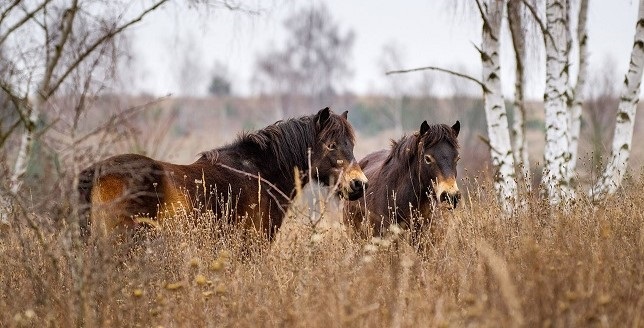In January 2015, when a herd of wild horses ran into a large ungulate reserve in the former Milovice military area near the Czech capital of Prague, one of the largest nature conservation changes in Central Europe in decades was launched.

In this way, the grazing of large herbivores was introduced to maintain large parts of the landscape in the region. “In the environmentally advanced countries of Europe, large ungulates have been used in landscape care for decades. We are happy that we could help with the introduction of this cost-saving method in the conditions of Central Europe,” said Dalibor Dostal, the director of the conservation organisation European Wildlife.
In 2018, the company also established another reserve for wild horses in Podyjí National Park near the border with Austria. “Large ungulates – both wild and domesticated – have always been among the main creators of the diversity of steppes, heaths and oak woods of the Podyjí region,” explains Robert Stejskal, biologist at the Podyjí National Park.
Thanks to the project of wild horse grazing, it was possible to resume these processes in a large area of the national park. “Pastures, until recently drowned in a dense growth of smothering grasses, are now crossed with horse paths and they turn into a flowery oasis full of rare plants and insects right before our eyes,” added Stejskal.
In six years, a total of nine reserves of large ungulates have been established in the Czech Republic.
The former military area of Milovice still remains the largest area, where wild horses share the reserve’s 230 hectares with European bison and back-bred aurochs. At other reserves, wild horses are also helping solve situations that nature conservation has not been able to cope with before.
“Since its founding, the Josefovské louky Bird Park has been addressing the issue of the overgrowth of dense wetland vegetation in the spring, when this reserve is meant to serve meadow birds, especially waders, as a nesting place. Waders prefer exposed areas rather than tall dense vegetation.
“The influence of wild horses imported in 2018 surprised even the ornithologists. Not only do they graze the stiffest wetland plants perfectly in time, but they also enter shallow waters, where they bite off the sprouting grass at the bottom with an unpretentious appetite. This prevents vegetation overgrowth in places where waders look for food,” says bird park manager Brenek Michalek from the Czech office of Birdlife International.
Scientists also appreciate the creation of reserves of large ungulates. “It is positive that this effective way of caring for the landscape is beginning to gain ground in the Czech Republic. However, these are still small reserves compared to similar projects abroad. For example, in neighbouring Germany, similar grazing reserves are spread over an area of up to 1,860 hectares, and in the Netherlands, it is even 5,000 hectares. Reserves of large ungulates in the Czech Republic should also go in this direction for many good reasons,” noted Miloslav Jirku from the Biology Centre of the Czech Academy of Sciences.
In addition, so-called natural grazing of large ungulates provides a solution to some of the current problems facing the today’s changing world.
“It is not only nature-friendly care of the landscape, but also a rational response to the growing need for long-term sustainability and independence from fossil fuels. Compared to other ways of caring for the landscape, natural grazing is cheap and large ungulates need only the local vegetation to graze large mountainous, waterlogged and otherwise demanding terrain.
“Not only do they use no fossil fuels to maintain the landscape, but their activities, for example, result in improving soil health and thus the ability of the landscape to retain water and prevent fires by removing highly flammable grass biomass,” said Miloslav Jirku, mentioning a few of the many positive impacts of large ungulates on nature.
The number of reserves for large herbivores should continue to increase in the future. “Protected landscape areas, national parks and cities or regions from other parts of the republic are coming to us, so large ungulates will start helping with the care of the landscape in other regions as well,” Dostal concluded.
The international impact of the Czech programme for the return of large ungulates does not mean only the provision of animals to the reserves abroad. For example, a domestic branch of the European Bison Conservation Centre, the international organization for the protection of European bison, was established as part of the cooperation of the Czech Landscape organization with scientists from the Biology Centre of the CAS.
“For the last two years, we have been heavily involved in the preparation of a new edition of the so-called Bison Action Plan. It is an important document that defines the strategy for the largest mammal in Europe for the coming decades. It is a breakthrough document because it fundamentally changes the international protection of the bison, as well as the management of its herds and populations across the continent,” emphasised Jirku.
The large herbivore reserve, dubbed the European Serengeti, was created in the former Milovice military area in 2015. It became the first place in the world to provide a joint home for three key native species of large European herbivores: wild horses, European bison and back-bred aurochs. The project has been rewarded with several prestigious prizes, such as the 2020 SDG award (for sustainable development goals) in the Climatic Change category.
The European Wildlife conservation organisation is currently organising a campaign to complete the unique reserve. The public and the business community can make donations as part of a charitable fundraising project on the website eurowildlife.org/donate. In 2015, the location became the first place in the world where three key species of large ungulates – wild horses, European bison and back-bred aurochs – are found in one reserve. The reserve has grown from initial 40 hectares to 230 hectares, and another 120 hectares are to be incorporated in its final phase.
